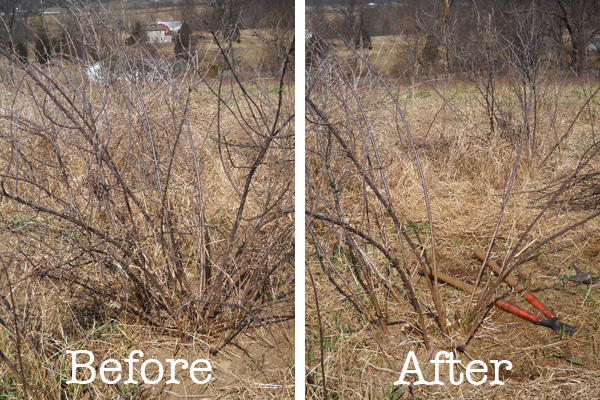-

Erin Donahue -

Christina Barkanic -

Brittany Trott -

Emily Wiley -

Jessica Reilley -

Chris Raines -

Will Nichols -

Emily Reddy -

Michele Marchetti -

Michele Frank -

James Gherardi -

Kit Henshaw -

Christina and Erin -

Kim Tait -

Erin McKinney -

Steve Spanelli -

Sam Komlenic -

Katherine Taylor Grofic -

James Eisenstein -

Jamie Oberdick -

Anna Lombardo -

LacCreta Holland -

Tony Ricci -

Local Food Journey -

Laura Young -

Kristin Camplese -

Harrison's Fresh + Local -

Danielle Matalonis -

Kristine A. -

Linda Weaver -

Naomi Elle Schwartz -

Dana Stuchul -

Cara McShane -

Brittany Smith -

Jessica Illuzzi - Frosty
-

Jessica Paholsky -

James Sechrengost -

Brad Yeckley -

Maya Althouse -

Jordan Reabold -

Kim Chase -

Maria Bryant - Alexandrea Scott
Farm Diary: Pruning in March
Posted by James Eisenstein on 03/30, 2012 at 09:12 AM

A black currant before and after pruning. Photo Credit James Eisenstein.
Most people know that pruning does not consist of attaching prunes to fruit trees and bushes, despite what Amelia Bedelia understood it to mean. But beyond that, I’ll wager that most folks who read Unpaid Field Hand only know that it involves some sort of cutting and thinning of fruit trees and canes.
Of course, you can learn all about it by going on the web and googling “fruit pruning.†But even after reading the 7,280,000 results available, you might be forgiven for still not knowing just how to do it. And for good reason. That’s because even the most knowledgeable experts sometimes give contradictory advice. Even Michael Phillips, whose book The Apple Grower is considered an authority to many apple cultivators, confesses that he hopes to know how to do it by the time he is eighty.
If you do not prune fruit trees and brambles (the word insiders use for many types of berry bushes), your planting will resemble a labyrinth that must be navigated to get to the fruit, which will be small, unappealing, and (in the case of trees) out of reach. So it is something that must be done, and most of it while the plants are still dormant.
In late February and early March, I set about pruning in the orchard and then turned to the currants and gooseberries. I find it to be a pleasant task, with each tree being a puzzle to solve. I guess if I worked at Harner’s or Way’s fruit farms, having to prune hundreds of trees might change my mind. But we have only about 40 trees, and of different ages to boot.
Training a new tree requires imagining what it will look like as small branches grow in the future, and more mature trees require decisions about what to cut and what to leave. The biggest obstacle most beginners face (I’m just beyond that stage) is fear of cutting too much and hurting the poor, innocent, silent, uncomplaining tree. You can cut too much, particularly from pears and cherries. But most beginners, including yours truly, prune too little, especially on apple trees. This results in your having to prune more heavily in later years, which temporary reduces yield.
Our fruit trees are just entering their bearing years, but we have mature currant and gooseberry bushes that should be yielding nice crops soon. Last year, we got some fruit, but far less than we should have. My theory last spring was, why cut branches that would bear fruit? Thinning would just mean less.
The mediocre harvest that resulted from following this strategy put us in a “what have we got to lose†position, so this year I actually followed the experts’ advice (they do agree on some things). Black currants, for example should be pruned to 9 or 10 canes, with an equal number of three year, two year, and one year olds. So I mustered my courage and hacked away, as the before/after pictures show. Stay tuned for a harvest report this June.
![]() Author: James Eisenstein
Author: James Eisenstein
Bio: Unpaid Field Hand at Jade Family Farm | Former Penn State Professor
- Our Local Food Journey comes to an end
- Winter isn’t a quiet time at the farm
- Get the taste of garden season right now by growing herbs indoors
- All you need to know about PASA’s Farming for the Future conference









NO COMMENTS